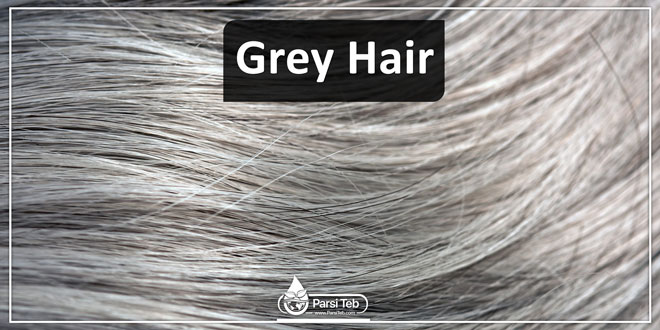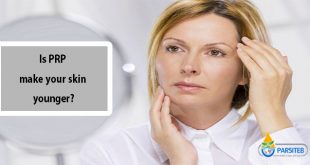Grey Hair is a symptom of improper protein synthesis. Hair grows white when the colour pigment (melanin) ceases to be produced in the hair follicle and small air spaces take its place. Pigment cells located at the base of each hair follicle produce the natural dominant colour of our youth. However, as a person grows older and reaches middle age, more and more of these pigment cells die and colour is lost from individual hairs. The result is that a person’s hair gradually begins to show more and more grey. Individual hairs each have an outer layer (the cuticle) of overlapping flat cells, underneath, which is the thick cortex, which consists of horn-like keratin. The inside of the hair is made of softer, rectangular cells. Hair colour is determined by the concentration and depth of melanin pigment in the cortex – this produces the whole spectrum of hair colour from blond to black, with very fair people having almost no melanin. When these melanocytes die, then the hair turns grey. Melanocytes produce the pigment melanin and they are the cells responsible for much of the coloring of the human body, including the hair. With age the melanocytes lose their ability to make pigment, so color is absent from new hair.
Grey hair is usually associated with ageing, but this is not always the case. Early greying of the hair is basically hereditary, and we can inherit it from one of our parents or grandparents. So if your father’s hair started to turn grey in his thirties there is a good chance yours will too. Grey hair can also be influenced by stress. A person experiencing a prolonged period of stress and anxiety may notice, over a period of time, white hairs gradually appearing. Malnutrition, worry, shock, deep sorrow, tension and other similar conditions may also slow down the production of melanin resulting in grey hair. Sever illness too can stop or affect the production of melanin. However, scientists have not been fully able to explain the exact causes of this change in colour of the hair.
Contrary to popular belief pulling out one grey hair will make two grow in its place is a myth. What can happen, however, is that if your hair is starting to turn grey and you pull one grey hair out, it may well be that the neighboring grey hair is just about to start growing, therefore two hairs in close proximity will appear at about the same time.
Home Remedies and Treatment
” Amla ” is the best cure for grey hair and falling hair. Regular massage of “amla” paste rubbed into the scalp has worked wonders in many cases, frequently reversing the process of greying or falling off of hair.
Massage your hairs with coconut oil and Lemon everyday for at least 15 minutes. There are instances of people having black hairs even up to the age of 60-70 years by using this method.
Soak about 10 to 12 rithas and 3 to 4 shikakai pods overnight in a pint of water. Next day, boil for a few minutes and strain. Use this liquid as a normal shampoo. Separately soak 10 to 12 dried amlas in half a cup of water overnight. Strain and use as a hair conditioner after your head bath. Leave it on the hair for ten minutes and rinse your hair with clean warm water. This will leave your hair smooth and shiny and also stop premature greying of your hair.
Mix lemon juice in castor oil and beat till frothy. Add ‘henna’ in to it. Apply the mixture evenly over the scalp, and bathe after an hour using ‘shikakai’ and ‘ritha’ shampoo as above. This checks greying of hair.
Take a cup of strong black tea (without milk), and to this add a tablespoon of salt. When cold, strain the tea and massage it on the roots. Leave it on for an hour, and then rinse with cold water. Do not shampoo it.
Nourishment and proper grooming is very important to keep the hair texture, growth, shin and luster in a good condition. Therefore use a shampoo & conditioner that suits your hair type. Choose products that are gentle, preferably without any harsh detergent like sodium lauryl sulfate. For daily washes, use a shampoo that is mild, gentle & moisturizing. Don’t use too much conditioner or else it makes hair greasy. Daily massage your hair with your fingertips; it helps proper blood circulation in the scalp.
Nourishment
Your hair needs the following nourishment:
a) Vitamin A – vitamin A is necessary for promoting a healthy scalp and gives body and glow to your hair. Include dark green vegetables and orange & yellow fruits & vegetables in your diet.
b) Vitamin B – vitamin B regulates the secretion of oil, keeps hair healthy & moisturized. Eat more of fresh green leafy vegetables, tomatoes, cauliflower, cereals, liver kidney, yogurt, bananas and green vegetables.
c) Minerals – minerals like zinc, iron & copper promote healthy hair. Food sources: zinc – red meat, chicken & green vegetables; iron – beef, dried apricots, red meat, parsley, eggs, wheat & sunflower seeds; copper – seafood, egg yolk & whole grains.
d) Proteins – consuming more of protein gives your hair natural shine and good texture. Include more of sprouted whole grains, cereals, meat and soy in your diet.
 Parsi Teb Physical and Mental Health Journal
Parsi Teb Physical and Mental Health Journal 

![RF [Radiofrequency treatment] (Part II)](https://en.parsiteb.com/wp-content/uploads/2019/08/parsi_teb-RF-Radiofrequency_treatment_2-310x165.jpg)

